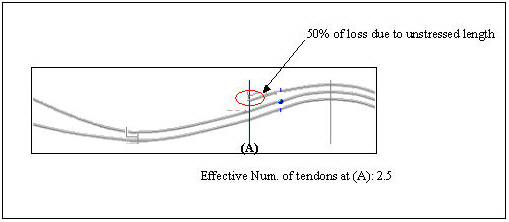Tendon Loss (Tendon Group)
Tendon losses are produced by friction, anchorage slip, elastic shortening, creep, shrinkage and relaxation.
From the Main Menu select Result > Result Tables > Tendon > Tendon Loss (Tendon Group)
Tendon Group: Select a Tendon Group for which the results will be produced. Tendon Group should be predefined prior to the analysis since the results are produced by Tendon Groups.
Stage: Select a construction stage for which the results will be produced.
Apply: Click the button to produce the tendon results for the corresponding Tendon Group and Construction Stage.
Elem: Element number
Part: Locations at which the tendon results are produced
Stress (After Immediate Loss): A
Remaining stress in tendon after deducting instantaneous losses.
Note Instantaneous losses for post-tensioned beams and pre-tensioned beams
Instantaneous losses for post-tensioned beams and pre-tensioned beams are different.
In a post-tensioned beam, friction loss and anchorage slip loss are included in the instantaneous loss. Because elastic shortening loss is considered to have taken place already at the time of prestressing tendons.
In a pre-tensioned beam on the other hand, elastic shortening loss is included in the instantaneous loss. Because friction loss and anchorage slip loss do not take place in a pre-tensioned beam. Elastic shortening loss occurs due to prestress and self weight. Here, only elastic shortening loss due to prestress is considered. The loss due to self weight is included in Elastic Deform. Loss below.
Elastic Deform. Loss: B
Other types of elastic shortening losses, which are caused by subsequent loadings (self weight, live loads, creep, shrinkage, etc.) after the prestressing force is applied, are included. Elastic shortening loss due to prestressing of other tendons as shown in the figure below is also included in Elastic Deform. Loss'.

Note
In order not to consider Elastic Deform. Loss, the Tendon Tension Loss Effect (Elastic Shortening) option must be checked off in the Construction Stage Analysis Control dialog.
(A+B)/A
The ratio of 'Stress(Elastic Loss)' to 'Stress(After Immediate Loss): B'. Here, 'Stress (Elastic Loss)' represents the sum of 'Stress (After Immediate Loss): A' + 'Elastic Deform. Loss: B'.
Creep&Shrinkage Loss: Stress loss of tendon due to creep and shrinkage
Relaxation Loss: Stress loss of tendon due to relaxation
Stress(After All Loss)/ Stress(After Immediate Loss)
The ratio of Stress(After All Loss) to Stress(After Immediate Loss). Here, Stress(After All Loss) represents remaining stress in tendon after deducting instantaneous loss and long-term loss.
Effective Num.
Effective number of tendons contained in the Tendon Group. Effective number accounts for the number of tendons on the assumption that the stresses concentrated over the unstressed length near the end anchorage zone are uniformly distributed throughout the entire section. For example, supposing that only 50% of tendons are valid at (A) due to the unstressed length near the anchorage zone, Effective Num. at (A) comes to 2.5. As long as unstressed length is not computed, Effective Num. is equal to the actual number of tendons.

|
|
Check the effective prestressing forces graph of tendons where tendon losses are reflected Right click on the table and select Tendon Time-dependent Loss Graph to check the effective prestressing forces of tendons excluding stress losses in a graph. |

Effective prestressing forces of tendons
.jpg)